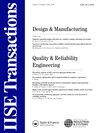Change Point Detection of Multimode Processes Considering Both Mode Transitions and Parameter Changes
IF 2
3区 工程技术
Q3 ENGINEERING, INDUSTRIAL
引用次数: 0
Abstract
AbstractMultimode processes are common in modern industry and refer to processes that work in multiple operating modes. Motivated by the torque control process of a wind turbine, we determine that there exist two types of changes in multimode processes: (1) mode transitions and (2) parameter changes. Detecting both types of changes is an important issue in practice, but existing methods mainly consider one type of change and thus do not work well. To address this issue, we propose a novel modeling framework for the offline change point detection problem of multimode processes, which simultaneously considers mode transitions and parameter changes. We characterize each mode with a parametric cost function and formulate the problem as an optimization model. In the model, two penalty terms penalize the number of change points, and a series of constraints specify the multimode characteristics. With certain assumptions, the asymptotic property ensures the accuracy of the model solution. To solve the model, we propose an iterative algorithm and develop a multimode-pruned exact linear time (multi-PELT) method for initialization. The simulation study and the real case study demonstrate the effectiveness of our method against the state-of-the-art methods in terms of the accuracy of change point detection, mode identification, and parameter estimation.Keywords: Change point detectionconstrained optimization modelmultimode processeswind turbine torque controlDisclaimerAs a service to authors and researchers we are providing this version of an accepted manuscript (AM). Copyediting, typesetting, and review of the resulting proofs will be undertaken on this manuscript before final publication of the Version of Record (VoR). During production and pre-press, errors may be discovered which could affect the content, and all legal disclaimers that apply to the journal relate to these versions also. Additional informationNotes on contributorsJun XuJun Xu is currently a Ph.D. student in Department of Industrial Engineering, Tsinghua University. He received his B.Eng. degree in Industrial Engineering from Tsinghua University in 2019. His research interests include modeling, monitoring, change detection and diagnosis of complex systems.Jie ZhouJie Zhou is a senior engineer in Goldwind Science & Technology Co.,Ltd, Beijing, China. He is focusing on wind turbine diagnosis and safety control. He is also currently working towards the D.Eng. degree in Industrial Engineering with Tsinghua University, Beijing, China. He received his B.S. and M.S. degrees in Electrical Engineering from Dalian University of Technology, Dalian, China.Xiaofang HuangXiaofang Huang is a senior engineer. She received her master's degree from Xidian University, Xi'an, China in 2006. She is currently a department lead of the R&D Center of Goldwind Science & Technology Co.,Ltd, mainly engaged in the development and localization of wind turbine main control system software, as well as the development of intelligent control and protection technology of wind turbines and wind farms.Kaibo WangKaibo Wang is a professor in Department of Industrial Engineering, Tsinghua University and the vice dean of Vanke School of Public Health, Tsinghua University. He received his B.Eng., and M.S. degrees in Mechatronics and Mechanical Engineering from Xi’an Jiaotong University, Xi’an, China, in 1999 and 2002 respectively, and Ph.D. in Industrial Engineering and Engineering Management from Hong Kong University of Science and Technology, Hong Kong, in 2006. His research focuses on statistical quality control and data-driven system modeling, monitoring, diagnosis and control, with a special emphasis on the integration of engineering knowledge and statistical theories for solving problems from the real industry.考虑模式转换和参数变化的多模进程变化点检测
摘要多模式过程是现代工业中常见的过程,是指在多种工作模式下工作的过程。在风力机转矩控制过程的激励下,我们确定了多模态过程中存在两种类型的变化:(1)模态转换和(2)参数变化。在实践中,检测这两种类型的变化是一个重要的问题,但现有的方法主要考虑一种类型的变化,因此效果不佳。为了解决这一问题,我们提出了一种新的多模式进程离线变化点检测建模框架,该框架同时考虑了模式转换和参数变化。我们用参数成本函数来描述每种模式,并将问题表述为优化模型。在该模型中,两个惩罚项对变化点的数量进行惩罚,一系列约束规定了多模态特征。在一定的假设条件下,渐近性保证了模型解的准确性。为了求解该模型,我们提出了一种迭代算法,并开发了一种多模修剪精确线性时间(multi-PELT)初始化方法。仿真研究和实际案例研究表明,在变点检测、模式识别和参数估计的准确性方面,我们的方法相对于最先进的方法是有效的。关键词:变化点检测约束优化模型多模式过程风力发电机转矩控制免责声明作为对作者和研究人员的服务,我们提供此版本的已接受稿件(AM)。在最终出版版本记录(VoR)之前,将对该手稿进行编辑、排版和审查。在制作和印前,可能会发现可能影响内容的错误,所有适用于期刊的法律免责声明也与这些版本有关。徐军,清华大学工业工程系博士研究生。他于2019年获得清华大学工业工程学士学位。他的研究兴趣包括复杂系统的建模、监测、变化检测和诊断。周杰,中国北京金风科技有限公司高级工程师。他专注于风力涡轮机的诊断和安全控制。他目前也在攻读博士学位。毕业于中国北京清华大学工业工程专业。他在大连理工大学获得电气工程学士学位和硕士学位。黄晓芳是一名高级工程师。她于2006年获得西安电子科技大学硕士学位。现任金风科技股份有限公司研发中心部门负责人,主要从事风电机组主控系统软件的开发和国产化,以及风电机组和风电场智能控制与保护技术的开发。王凯波,清华大学工业工程系教授、万科公共卫生学院副院长。他分别于1999年和2002年获得西安交通大学机电工程学士学位和硕士学位,并于2006年获得香港科技大学工业工程和工程管理博士学位。他的研究主要集中在统计质量控制和数据驱动的系统建模、监测、诊断和控制,特别强调工程知识和统计理论的整合,以解决来自实际工业的问题。
本文章由计算机程序翻译,如有差异,请以英文原文为准。
求助全文
约1分钟内获得全文
求助全文
来源期刊

IISE Transactions
Engineering-Industrial and Manufacturing Engineering
CiteScore
5.70
自引率
7.70%
发文量
93
期刊介绍:
IISE Transactions is currently abstracted/indexed in the following services: CSA/ASCE Civil Engineering Abstracts; CSA-Computer & Information Systems Abstracts; CSA-Corrosion Abstracts; CSA-Electronics & Communications Abstracts; CSA-Engineered Materials Abstracts; CSA-Materials Research Database with METADEX; CSA-Mechanical & Transportation Engineering Abstracts; CSA-Solid State & Superconductivity Abstracts; INSPEC Information Services and Science Citation Index.
Institute of Industrial and Systems Engineers and our publisher Taylor & Francis make every effort to ensure the accuracy of all the information (the "Content") contained in our publications. However, Institute of Industrial and Systems Engineers and our publisher Taylor & Francis, our agents, and our licensors make no representations or warranties whatsoever as to the accuracy, completeness, or suitability for any purpose of the Content. Any opinions and views expressed in this publication are the opinions and views of the authors, and are not the views of or endorsed by Institute of Industrial and Systems Engineers and our publisher Taylor & Francis. The accuracy of the Content should not be relied upon and should be independently verified with primary sources of information. Institute of Industrial and Systems Engineers and our publisher Taylor & Francis shall not be liable for any losses, actions, claims, proceedings, demands, costs, expenses, damages, and other liabilities whatsoever or howsoever caused arising directly or indirectly in connection with, in relation to, or arising out of the use of the Content. Terms & Conditions of access and use can be found at http://www.tandfonline.com/page/terms-and-conditions .
 求助内容:
求助内容: 应助结果提醒方式:
应助结果提醒方式:


